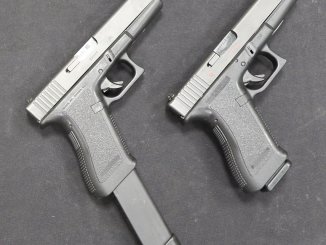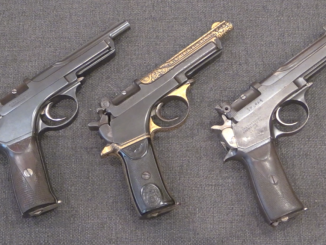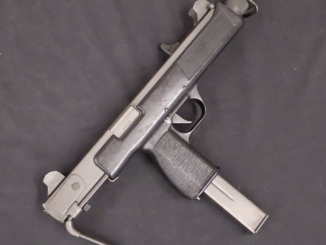In the 1960s, Steyr Daimler Pusch developed a modern sniper rifle for the Austrian military (and also for commercial civilian sale). It was adopted as the SSG-69 (Scharfschützen-Gewehr; sharpshooter’s rifle), replacing the SSG-98k in military service. Mechanically, the SSG-69 uses a bolt with six rear-mounted locking lugs in 3 pairs, giving it a short 60 degree throw. The stock is made of polymer and the barrel is cold hammer-forged, both fairly cutting-edge elements at the time of its design. It was a factory 1MOA rifle, also something considered typical today, but quite impressive ein the 1960s.
In its military configuration, the rifle used a 5-round detachable rotary magazine and a Kohl’s ZF69 6x42mm telescopic sight, along with backup barrel-mounted iron sights. This example is a civilian one, differing from the military pattern by having a double set trigger, a black stock (instead of green) and by including a second trigger guard designed to use traditional box magazines. The basic action was made in a wide variety of other civilian configurations, ranging in caliber from .222 Remington up to .458 Winchester Magnum.
Make sure to also check out 9 Hole Reviews’ field trial of the SSG-69 in military configuration out to 800 yards:




The name of the SSG69 military scope maker is “Kahles” not “Kohl’s”.
Solid production sniper rifle. I owned one for a few years, but as it shot a lot better than I could, I ill-advisedly traded it off to a friend who fell in love with it and who could make it live up to its potential.
I read up on the Austrian doctrine for this rifle, and I have to say that what I came away from that with was that the way they were using it? It would have been a lot smarter to procure something along the lines of the Dragunov or the M110; Austrians, at least in the resources I could find, seemed to be using this rifle more in the mode of a Designated Marksman Rifle, rather than the classical “scout and stalk” mode that the Brits and the USMC used their rifles like the M70. My friend was a former Marine, and he really liked the SSG as a pure shooter.
There were a couple of successive Kahles scopes for these. The first was the ZF-69, and the one I had on top of mine was a then brand-new ZF-84. What the differences were, I’m unsure, but the ZF-84 appeared to have better clarity and coatings on it. Purely subjective… The ZF-69 I had access to was a rather used-and-abused example, and maybe it was just that my ZF-84 was new.
“(…)stock is made of polymer(…)”
Is this exactly same polymer as used in another Austrian military weapon of same year, namely MPi 69 http://modernfirearms.net/en/submachine-guns/austria-submachine-guns/steyr-mpi-69-eng/ or do their compositions differ?
There were other rifles using the rear locking bolt design. The one that comes readily to mind is the Remington 788 designed as a budget gun that actually cost more to make than the 700 series. However, two different 788s that I worked with in .308 Win. were serious 1/2 to 3/4 inch consistent when I did my part behind the trigger. A great underappreciated rifle with superior accuracy potential in most calibers. I would love to work with the 788 in both .30-30 and .44 magnum to see why there were short runs of those calibers.
The 788 in .30 WCF and .44 Rem. Magnum didn’t sell because to the accuracy fanatics in the 1970s, those were “unsuitable” cartridges. Both were rimmed instead of being “proper” rimless rounds (Eck!), one was three-quarters of a century old and tapered to boot (Oh Noes!), and the other was a redeployed revolver round (Horrors!).
In reality, the .30-30 has always been one of our most inherently accurate rifle cartridges, notably with the heavier 170-grain bullets. The Winchester 1894 and Savage 1899 lever-actions in good condition generally shoot at least as well as most bolt-actions over similar distances out to 250 meters. And it should be noted that like the 788, both are rear-locking actions.
As for the .44 Magnum, if you restrict its use to handguns you are doing it wrong. The .44 is basically a carbine cartridge that strayed into handgun territory. To achieve its full potential in accuracy, velocity and power, you need at least a 16-inch barrel.
In Cooper on Handguns, Col. Jeff observed that based on tests, he had founds that an expert pistol shot firing the .44 Magnum 8 3/8″ revolver off a rest was a deadly opponent at 300 yards. He later determined that in a 20″ rifle barrel, the .44 was accurate and effective at 350 meters (about 380 yards or so).
What surprised him was that in a 20-inch barreled lever-action, the .357 Magnum 125-grain loads posted average velocities above 2,100 F/S. Putting them not far behind the 124-grain FMJ service loads of the 7.62 x 39mm.
Putting the .44 magnum in the 788 with a good 4X scope on top made it a valid “police” rifle back in the early to mid 1970s. Same for the .30-30 in that platform.
I’ve often wondered just what the .357 Magnum would have been capable of in the 788 platform. Let alone the .357 Maximum.
cheers
eon
“(…)three-quarters of a century old(…)”
Whilst this itself should not exclude this cartridge, it did to my understanding influence shape of bullet, which was not Spitzer and thus unlike cartridges with such bullet does not harness important progress in area of external ballistics.
.30-30 is normally loaded with roundhead bullets, because pointed bullets can lead to accidental ignition of cartridges in tube magazines, where the cartridges are stacked one behind the other. Recoil can and has pushed the point into the ignition cap of another cartridge. The 8 mm Level rifles had this problem as well as another example. Which then promoted the French to press a ringshaped groove inte the head of 8 mm level cases. Also that weird shape of the cartridge case was done for safety to keep the bullets away from the heads. Today there is the Leverelution line of cartridges from Hornady with plastic tips so as not to have that risk of detonation.
When using .30-30 in a rifle without a tube magazine you can of course load any .30 calibe bullet you like.
“(…)wondered just what the .357 Magnum would have been capable of in the 788 platform.(…)”
How actually accurate is Ruger® 77/357™? https://www.ruger.com/products/77Series77357/models.html claims that Cold hammer-forged barrel results in ultra-precise rifling that provides exceptional accuracy and longevity. but it is really is or it just marketing gimmick?
“(…)There were other rifles using the rear locking bolt design(…)”
If I am not mistaken this holds true for British L42A1 sniper rifle https://modernfirearms.net/en/sniper-rifles/standart-caliber-rifles/great-britain-standart-caliber-rifles/enfield-l42a1-i-enforcer-eng/
The L42/Enforcer consistently outshot the Rifle No.4 T of WW2, mostly because it was rebuilt with a free-floated heavy barrel in 7.62 x 51mm.
I’ve noticed over the years that “semi-sporterized” SMLEs, meaning ones in which all the stuff from forestock and muzzle cap to upper handguard have been removed back to the actual forend itself, consistently shoot tighter groups than “issue” No.1 MK IIIs or etc.
And yes, “half-magazine” Winchester and Marlin lever actions tend to shoot tighter than ones with full-length tubular magazines. The Model 64 and Model 61 being cases in point.
The moral is that to get better accuracy, stop hanging crap on the barrel.
cheers
eon
The Remington 788 also managed to avoid getting the “walker” trigger, that had a connector piece that floated around between the trigger and the sear
The disadvantages of the 788 were case stretch due to the rear locking, and poor camming for chambering and extraction
The poor camming is more likely in a bolt with 30° of rotation compared to 90° rotation, but it isn’t a necessary corollary of <90° bolt lift, as the old Shultz and Larsen actions with 4 rear locking lugs arranged around the bolt, had fairly decent camming
Along with a price tag that would buy you several remington 788s
.30-30 doesn’t make a lot of sense in a rifle that has a box (or especially a rotary) mag and that’s also available in .308
.30-30, makes sense in a Winchester 94 or a marlin lever action, with their tubular magazines
The invariable flat nose bullets in factory .30-30 ammunition, are essential for the tube mags
But not necessary for box mags like the 788 (or rotary mags like the Savage 99).
.308 and .300 Savage will do everything ballisically that. 30-30 will do, and more, and factory loaded pointed bullets will retain velocity and energy far better than equivalent weight flat nosed bullets. The pointed bullets will also suffer less wind drift.
I never managed to get a good look at the “rotary” mags for that series of Steyr rifles
The impression that I got from limited looks, was that it had more in common with an ordinary single stack box mag than it had with an actual Schoenauer (or even a Savage 99) rotary mag that individually holds and guides each cartridge and individually protects each bullet tip
That’s about right, I think. Very simplistic, compared to the only other example of a Mannlicher rotary mag that I’ve handled.
I think that may have been unique to the SSG-69, though. I remember handling some of the sporting versions Mannlicher had on sale at Frankonia Jagd when I was stationed in Germany, and I remember looking at their magazines and going “Huh… That’s not like mine…” I didn’t have rounds to cycle through, or see loaded up, soooo… I really can’t say for sure.
Should say “vintage pre-WWI Mannlicher”, rather than any of the newer breeds.